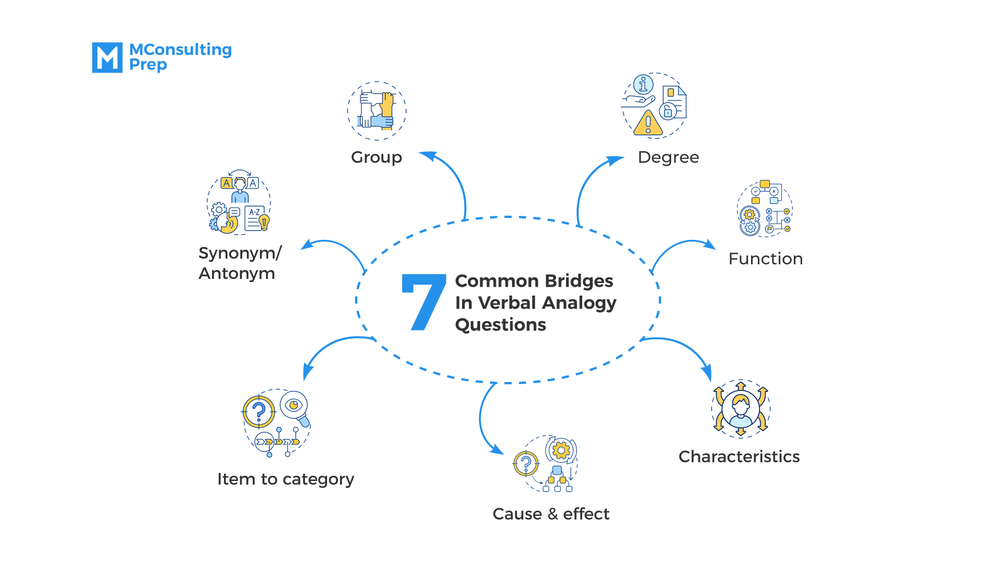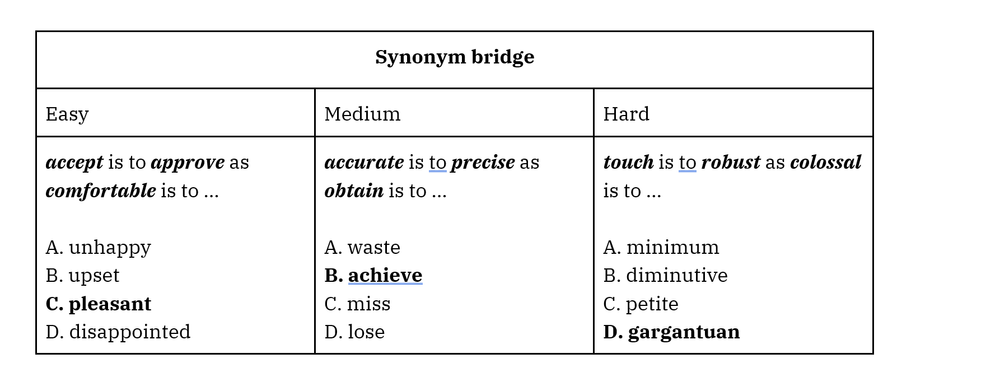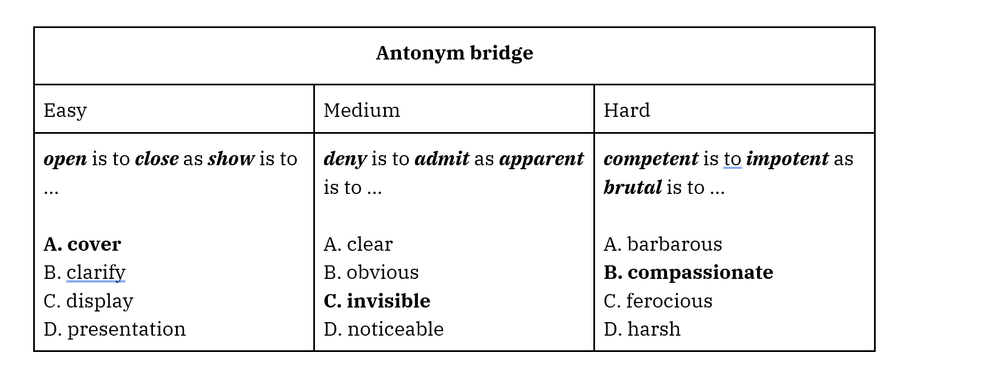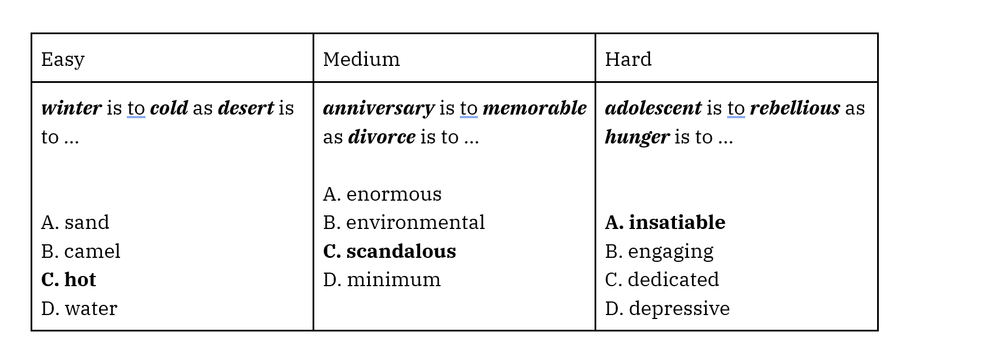Verbal analogy tests are often used in the hiring process to measure candidates’ logic and reasoning skills and word knowledge. To solve verbal analogy questions, candidates first need to understand the word’s definitions and use that knowledge to explore how the words are related.
Typically, there are some common word bridges that can help you easily define the relationship between words. This blog gives an insight into the verbal analogy test, as well as introduces the 7 widely-seen word connections.
Let’s dive right in!
Table of Contents
What is a Verbal Analogy Test?
Verbal analogy tests measure your ability to recognize relationships between pairs or sets of words. The questions can include a variety of words and concept connections, but the question structure remains similar in different tests.
Read more: Verbal Reasoning Tests: The Ultimate Guide (Free Mock Tests)
A verbal analogy question typically comprises two parts.
- Part 1 provides an example word pair with a specific relationship.
- Part 2 shows a word – your task is to find its counterpart according to the relationship of the given example.
The most common format of a verbal analogy question will look like this:
Word1 is to Word2 as Word3 is to?
A. Word4
B. Word5
C. Word6
D. Word7
7 common bridges in Verbal Analogy Tests
After days of research, we’ve come up with 7 mostly-used bridges in verbal analogy tests. Once get familiar with these 7 word connections, you can deal with verbal analogy questions smoothly. In addition to the definitions of the bridges, we also provide detailed examples with easy, medium, and hard levels. Discover now!
- Synonym/Antonym
- Group
- Characteristics
- Function
- Degree
- Item to category
- Cause & effect

Of course, there are many other bridges that may appear in verbal analogy tests. Below are just the most popular word relationships we’ve found in verbal reasoning tests from multiple test providers. So, develop as wide as possible vocabulary to get yourself ready for the real verbal analogy tests.
Synonym/ Antonym
As its name implies, the synonym bridge requires you to choose a word that has the same meaning as the given word.

Meanwhile, the antonym bridge asks you to pick a word that has an opposite meaning to the provided word.

Characteristics
The characteristic bridge asks you to pick one word that describes the other.
Group
The Group bridge requires you to choose a word that is a part of the other.


Function
The function bridge covers one word naming an object and the other describing its function.

Degree
The degree bridge requires you to identify the nuance of meaning in degree among pairs of words.

Item to Category
The item to category bridge asks you to choose one word that is a type of the other.

Cause & Effect
The cause & effect bridge asks you to choose one word that may lead to the other.

Which test providers offer verbal analogy tests?
Verbal analogy tests are not really common current test providers in the market. Only Criteria Corp, Test Partnership and Cubiks provide verbal analogy questions in their aptitude tests.
CCAT (Criteria Cognitive Aptitude Test)
Here is an example of verbal analogy questions in the CCAT.
MANGO is to FRUIT as …
A. BIKE is to CAR
B. SPEAK is to LISTEN
C. BOX is to STACK
D. DOCTOR is to HOSPITAL
E. BOOT is to SHOE
Answer: E
Explanation: The relationship between MANGO and FRUIT is Item to Category because MANGO is one kind of FRUIT. The same relationship exists between BOOT is to SHOE.
This type of question is included in the Criteria Cognitive Aptitude Test (CCAT). This simulation covers 50 questions under a time limit of 15 minutes – test takers have less than 20 seconds for one question.
The CCAT is one of the primary attitude tests produced by Criteria Corp., and one of the widely-used hiring tests in use. The test is used by tons of companies all over the world to measure different crucial cognitive skills.
Cubiks
Here is an example of verbal analogy questions in Cubiks tests.

Source: Cubiks
Answer: A
Explanation: Cubiks provides verbal analogy questions in the verbal section of Logiks (Intermediate). This Intermediate-level test consists of 50 questions in 3 sections under a time limit of 12 minutes – candidates have 4 minutes per section.
- Verbal: 24 questions
- Numerical: 16 questions
- Abstract: 10 questions
Cubiks’s ability tests are divided into 2 types, all exploring how you process and reason with various kinds of information, like verbal, numerical, and the more abstract and non-verbal type.
- Logiks (Intermediate)
- Logiks (Advanced)
Test partnership
Verbal analogy tests from Test Partnership are in the form of a valid and fair gamified assessment – Word Logic.

Source: TestPartnership
Word Logic is one of the major gamified tests in the MindmetriQ Gamified Assessments from Test Partnership.
MindmetriQ Gamified Assessments:
- Pipe Puzzle
- Shape Spinner
- Word Logic (Verbal Analogy Test)
- Link Swipe
- Net the Numbers
- Number Racer
Build vocabulary to pass verbal analogy tests
The best way to pass verbal analogy tests is to enrich your vocabulary because the main purpose of these tests is to assess your knowledge of English vocabulary.
As mentioned above, verbal analogy questions are often based on a specific bridge. Thus, when you learn a word, it’s essential to pay attention to its word association and learn it in a certain context.
There is a number of reliable English dictionaries such as Merriam-Webster Dictionary, Oxford Learner’s Dictionaries, Cambridge English Dictionary, Longman Dictionary, Collins Dictionary, Cambridge Thesaurus, etc. Especially, the Merriam-Webster Dictionary would be ideal for your vocabulary learning as it contains unusual nuances of words that you may not find in any other sources.
What about the most effective way to pass verbal analogy tests?
Undeniably, it’s practice.
MConsultingPrep includes a range of verbal analogy questions in our verbal reasoning practice tests. That helps you get familiar with various word relationships and increase your speed efficiently. Try a free test now!
/filters:quality(75)//case_thumb/public/1699589977462_aptitude_tests_package_4_x.png)